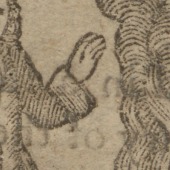Particulars of the execution and confession of the five unfortunate men, John Dennis, George Crow, W. Beamis the elder, T. South the younger, and Isaac Harley, for the horrid and awful crime of rioting. Who were executed at Ely in Cambridgeshire, on Saturday, July 13th, 1816
North Shields: W. Orange, printer, [1816?]
The year 1816 was a time of low wages and widespread unemployment, especially among those working in agriculture. The result was poverty, discontent and (perhaps inevitably?) rioting. Witnesses of the events in Ely describe a mob of fifty to one hundred people, armed with bludgeons and cleavers, breaking shutters and windows of shops and private houses, then threatening the householders, destroying furniture and stealing any portable valuables. The authorities were clearly alarmed and arrested 83 people in connection with the riots, of whom five were executed for robbery and burglary. The remarks of the judge at the beginning of the trial expressed the view of those in authority: although some had admittedly suffered due to the lack of employment, these people would only harm their own and their families’ future prospects by rioting. The judge stressed that there were plenty of charities for poor relief and that meanwhile the submission of a petition to the authorities was the most effective means of changing the situation.
In these circumstances the occasion of the execution provided an opportunity to show that order had been restored and that future wrongdoing would be similarly punished. Clergy, military and prominent members of local society were all included in the procession to the execution site. Their particular dress and emblems of authority emphasised that the community was united in condemning the wrongdoing. This report goes to great lengths to emphasise the effect of the execution on those watching. At this date executions were still carried out in public in order to act as a deterrent: it was not until 1868 that public opinion had changed to the point when it was felt that watching an execution could have a bad moral effect on spectators. There is a memorial plaque on the south wall of the west tower of St Mary’s Church, Ely, Cambridgeshire, to the five rioters executed in Ely. After listing their names, it concludes, “May their awful Fate be a warning to others.”
Broadsides.B.81.6
Not on display in physical exhibition








